An Exhibition Featuring A Timeline Of The First Appearances Of Positive Black Animation Characters In Television History
Funky Turns 50: Black Character Revolution Firsts Exhibition
The Funky Turns 40: Black Character Revolution Firsts panel exhibition is now Funky Turns 50!
Same awesome exhibition, but the cartoons are now celebrating their 50th anniversaries!!!
The Funky Turns 50: Black Character Revolution Firsts panel exhibition features a timeline of the first appearances of positive Black animation characters in television history and highlights the historic significance of these appearances in Saturday morning cartoons and specials during the late 1960’s / 1970’s.
- Celebrates the 50th anniversaries of these stereotype breaking Black animation character appearances.
- Highlights a unique Black history milestone and significant cultural victory resulting from the Civil Rights Movement in an uplifting way.
- Positively engages a multicultural and intergenerational audience.
- Attracts new visitors and school trips.
- Generates positive press and social media coverage.
- Extends the reach of our PHENOMENALLY SUCCESSFUL Funky Turns 50: Black Character Revolution Animation Art Exhibition.
Exhibition panels now feature FUNKY new graphics!
The article appeared on the front page of the March 20, 2014 Arts section.
Historical Overview
Picking up where comic strips left off in the early 20th century, theatrical cartoon film shorts portrayed Blacks in a racially derogatory and stereotypical manner as cannibals, coons, mammies and Stepin Fetchit characters with exaggerated features and ignorant dialect.
From 1900 to 1960, over 600 cartoon shorts featuring Black characters were produced by some of Hollywood’s greatest White animators and biggest film studios. Several famous Black jazz musicians such as Cab Calloway, Fats Waller and Louis Armstrong were also portrayed as stereotypical caricatures. In the 1950’s, several of these racist cartoons were shown on television. As a result of the civil rights movement, in the 1960’s the racial content of many of these cartoons was edited out or the cartoons were pulled from television altogether.
Notably, The Censored Eleven, a group of Looney Tunes and Merrie Melodies cartoons were banned from broadcast because they were deemed to be too offensive for contemporary audiences. In the case of The Censored Eleven, racist themes were so essential and so completely pervasive in the cartoons that no amount of selective editing could ever make them acceptable for distribution.
After sixty years of negative cartoon images, it wasn’t until the late 1960’s / early 1970’s that Saturday Morning television cartoons started to feature image affirming Black characters with a modern look and positive story lines that delivered culturally relevant messages.
This 1970‘s revolution in how Black animation characters were developed and portrayed in Hollywood represents historic change and the ultimate manifestation of Dr. Martin Luther King’s dream.
For the first time characters of all races lived, played and worked together as equals. For the first time Black children could see cartoon characters that looked, talked and acted more realistically like them, such as Fat Albert and the Cosby Kids, as well as more positive depictions of their favorite Black music icons and sports heroes like The Jackson 5ive featuring Michael Jackson and his brothers, The Harlem Globetrotters and I Am The Greatest featuring Muhammad Ali.
For the first time, Black children had cartoon role models who taught positive messages like family values, the importance of education, friendship, civic duty, personal responsibility and sportsmanship. For the first time cartoons like Josie and The Pussy Cats, Star Trek and Kid Power featured strong Black female characters and multicultural casts. These cartoons not only changed the way that Black kids saw themselves but the way that white kids saw them as well.
Also, for the first time, Black people like Berry Gordy led development of animated television programming featuring Black characters, from concept through to art creation and production.
Back in the 1970‘s everybody watched the same cartoons. Since then, many of these cartoons have re-aired on cable networks reaching new generations of children. Fifty years later, the legacy of these revolutionary cartoons has eclipsed the stereotypical images that came before and have paved the way for a new generation of Black animation like The Proud Family, Little Bill, Static Shock, Fillmore and Doc McStuffins!
Not surprisingly, the Black Character Revolution generation was the first to produce and elect the first Black President of the United States. The Funky Turns 50: Black Character Revolution exhibition features original production cels and drawings and limited edition cels from this turning point in cartoon history where Black and White animators created positive Black characters and Black stories for all to enjoy, including: Fat Albert And The Cosby Kids, The Jackson 5ive, The Harlem Globetrotters, Valerie – Josie and The Pussy Cats; Lt. Uhura – Star Trek Animated Series, Muhammad Ali – I Am The Greatest, Billy Jo Jive – Sesame Street, Verb: That’s What’s Happening – School House Rock and Franklin – Peanuts.
At one time, thousands of hand-painted cels were created and used under the camera to animate every TV and theatrical cartoon. Today’s animation is all computer generated, so hand painted cels represent a lost art form. As relatively little Black animation was produced in the 1970’s and beyond, original production artwork is scarce and rare. Although limited edition reprints of selected scenes from many cartoons and films have been produced, there are very few that have been created from Black animation.
Historical Firsts
Funky Turns 50: Black Character Revolution commemorates the 50th anniversaries of 1970’s Saturday morning cartoons that featured positive Black characters for the first time in television history. The animation art exhibition highlights these cartoons that represent several historical firsts, such as:
- First positive Black male character in a Saturday morning cartoon series – First positive Black male musician character in a Saturday morning cartoon series – Peter Jones – The Hardy Boys (1969)
- First positive Black cast cartoon – Black cast cartoon special to appear on television – First positive Black cast cartoon / Black cast cartoon special to be created from a comedy routine – Hey, Hey, Hey, It’s Fat Albert primetime special – Based upon Bill Cosby’s 1967 Buck, Buck comedy routine from his Revenge Album (1969)
- First positive Black male character in a primetime cartoon series – First positive Black athlete character in a primetime cartoon series – Freight Train – Where’s Huddles (1970)
- First positive Black cast Saturday morning cartoon series – First positive Black cast Saturday morning cartoon series featuring Black athletes – Harlem Globetrotters (1970)
- First positive Black female character in a Saturday morning cartoon series – First positive Black female musician character in a Saturday morning cartoon series – Valerie Brown – Josie And The Pussy Cats (1970)
- First positive Black cast Saturday morning cartoon series featuring Black musicians – First television series produced by Motown – Second positive Black cast Saturday morning cartoon series – The Jackson 5ive (1971)
- Longest running positive Black cast Saturday morning cartoon series – Third positive Black cast Saturday morning cartoon series – Fat Albert And The Cosby Kids (1972-1985)
- First truly multicultural Saturday morning cartoon series – First positive Saturday morning cartoon series featuring Black characters to be created from a syndicated comic strip – Kid Power – Based upon Morrie Turner’s Wee Pals comic strip (1972)
- First positive Black characters from a television series, The Flip Wilson Show, to appear as the same characters in primetime cartoon special – Clerow Wilson And The Miracle Of P.S. 14 (1972)
- First Schoolhouse Rock episode to feature Black Characters – I Got Six (1973)
- First Black character to appear in the Peanuts comic strip (introduced July 31, 1968) – First Black character to appear in a Peanuts cartoon special – Franklin Armstrong – There’s No Time For Love Charlie Brown (1973)
- First positive Black character from a television series to appear as the same character in a Saturday morning cartoon series – Lt. Uhura – Star Trek (1973)
- First Black male superhero character in a cartoon – second Schoolhouse Rock episode to feature Black Characters – Verb (1974)
- First Black male superhero character in a Saturday morning cartoon series – Second Black male superhero character – Hong Kong Phooey (1974)
- First Black male character to appear in Archie comics as a member of the gang – First Black male character to appear as a member of the Archie’s gang in a Saturday morning cartoon series – Chuck Clayton – U.S. Of Archie (1974)
- First Black female superhero character in a Saturday morning cartoon series – Astrea – Space Sentinels (1977)
- First positive cartoon series featuring Black characters to be created from a series of children’s books – Billy Jo Jive – Based upon Ted and John Shearer’s Billy Jo Jive book series – Aired as segment during Sesame Street (1978)
- First Black superhero duo to appear in a Saturday morning cartoon series – First Black Husband and Wife superhero duo to appear in a Saturday morning cartoon series – Micro Woman and Super Stretch – Aired as segment during Tarzan and the Super 7 (1979)
- First Black superhero team to appear in a Saturday morning cartoon series – Third Saturday morning cartoon series to feature The Harlem Globetrotters – The Super Globetrotters (1979)
- First time that Black people like Berry Gordy led the development of animated television programming featuring Black characters, from concept through to art creation and production
Exhibition Schedule
- Brown V. Board Of Education National Historic Site – Topeka, KS – July, 2015
- Bessie Smith Cultural Center – Chattanooga, TN – September 1 – October 31, 2015
- Purdue University Black Cultural Center – West Lafayette, IN – February 1 – March 31, 2016
- VCU Kinetic Imaging – Virginia Commonwealth University – Richmond, VA – August 24 – September 11, 2016
- Plainfield Public Library – Plainfield, NJ – February 4 – March 31, 2017
- Central Library of Rochester & Monroe County, Local History and Genealogy Division – Rochester, NY – February 1 – June 29, 2024
You can see results for all of the Funky Turns 50: Black Character Revolution Firsts Exhibition stops to date by clicking on the links above or clicking here
Exhibition Promotion
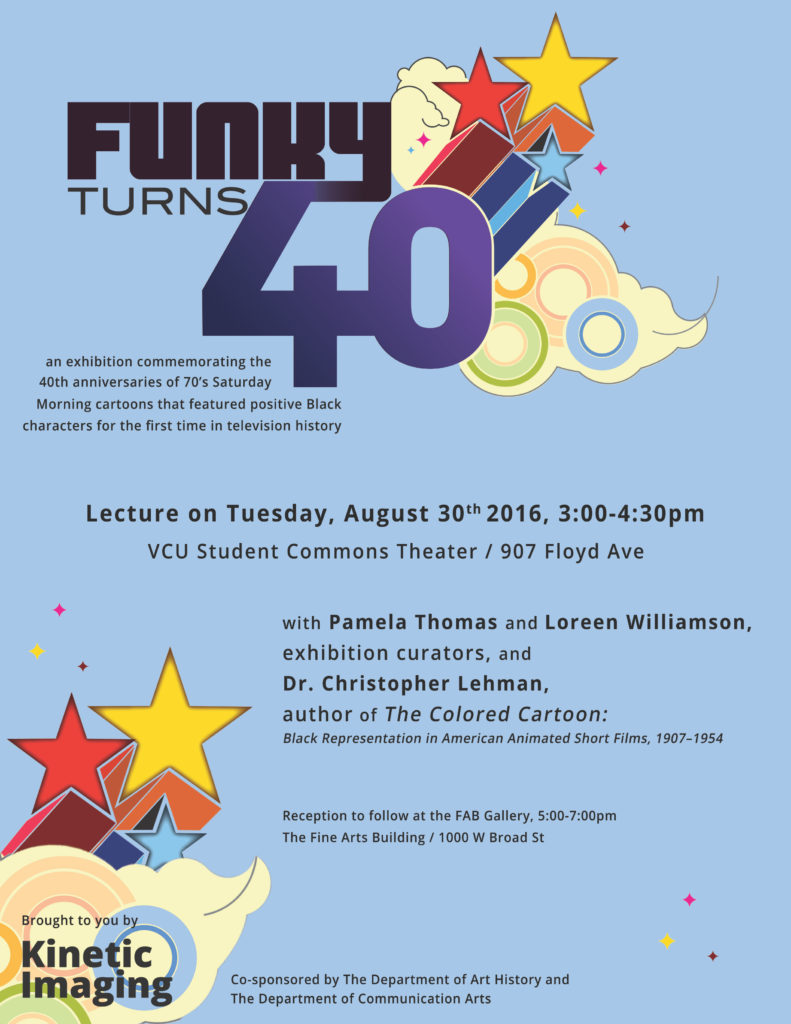
Exhibition Lecture
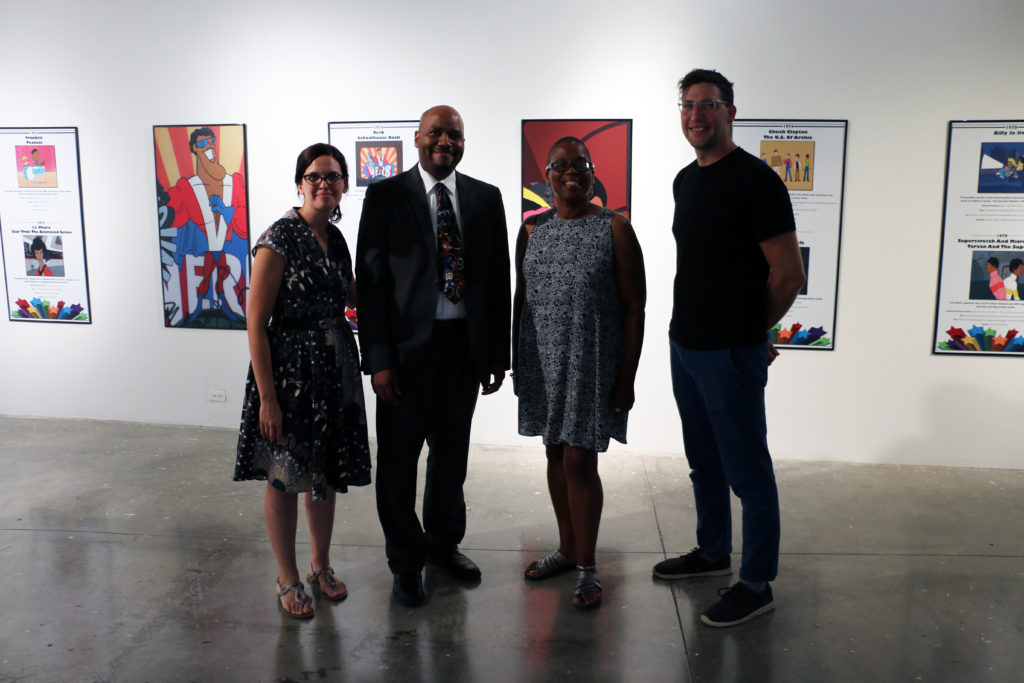
At fourth stop, at VCU Kinetic Imaging, the Curators of the Museum Of UnCut Funk held a lecture with Dr. Christopher Lehman, author of The Colored Cartoon, about the racist legacy of pre-1970’s Black cartoon characters and the barrier breaking significance of the 1970’s Black cartoon characters. You can view the lecture below.
Media Coverage
You can read the press releases for Funky Turns 50: Black Character Revolution Firsts Panel Exhibition below:
The exhibition was covered by the following local media in Topeka, Kansas:
The exhibition was covered by the following local media in West Lafayette, Indiana:
You can see all of the press and social media coverage of Funky Turns 50: Black Character Revolution Firsts below:
Exhibition Specs
Funky Turns 50: Black Character Revolution Firsts includes 24 text, timeline and cartoon character panels that capture key images from the animation art exhibition.
Approximate space required:
- 25 panels – 46×24 – 60 running feet
Additional Information
For more information and rental fees or to book the Funky Turns 50: Black Character Revolution Firsts Exhibition please contact the Curator, Sista ToFunky.
Curators are available for Curator’s Talks, Curated Tours, Expert Panels, Lectures. For more information or to book the Curators please contact the Curator, Sista ToFunky.
Museum, Cultural Institution, and Library Partners
We would like to thank the following museums, cultural institutions and libraries for hosting our Funky Turns 50: Black Character Revolution Firsts Panel Exhibition.
All rights reserved.
©2024 BET: Soul Train
©2024 Campbell-Silver-Cosby Corporation: Hey, Hey, Hey, It’s Fat Albert Primetime Special
©2024 Clerow Productions, ©DePatie-Freleng: Clerow Wilson And The Miracle Of P.S. 14
©2024 Comcast NBC Universal.: Archie / U.S. Of Archie, Fat Albert and the Cosby Kids, Hardy Boys, Kid Power, Space Sentinels, Star Trek, Tarzan And The Super 7 / Super Stretch and Micro Woman, The Jackson 5ive
©2024 Disney: Schoolhouse Rock
©2024 Peanuts Worldwide LLC: Franklin
©2024 Shearer Visuals, ©2024 Sesame Workshop: Billy Jo Jive
©2024 Warner Bros. Entertainment Inc.: Fangface, Harlem Globetrotters, Hong Kong Phooey, Josie And The Pussycats, Super Globetrotters, Where’s Huddles

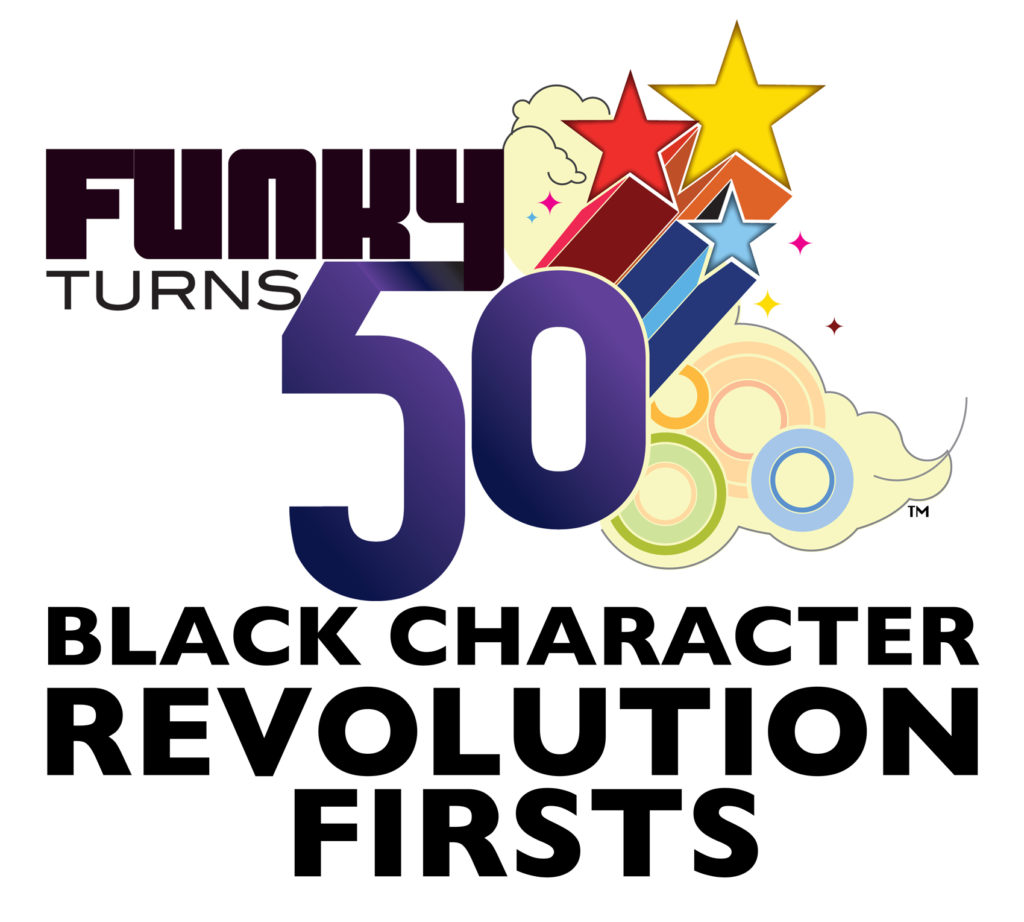
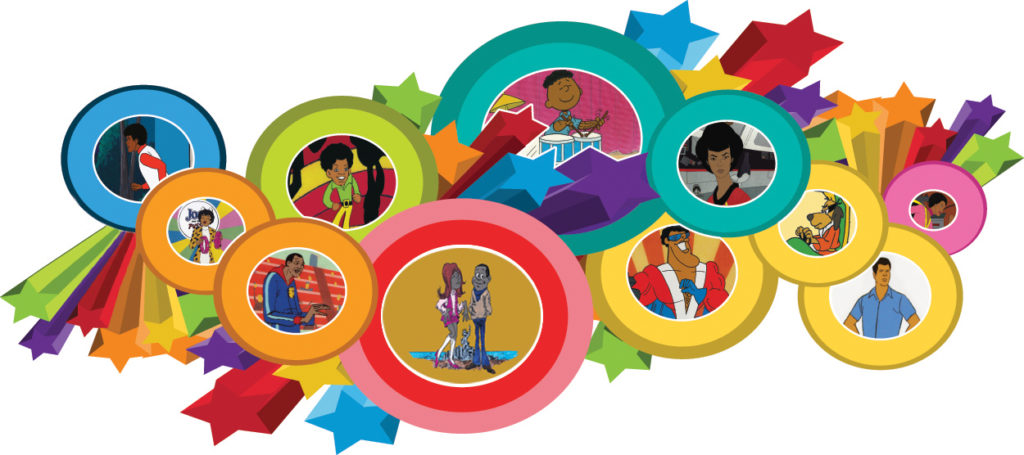
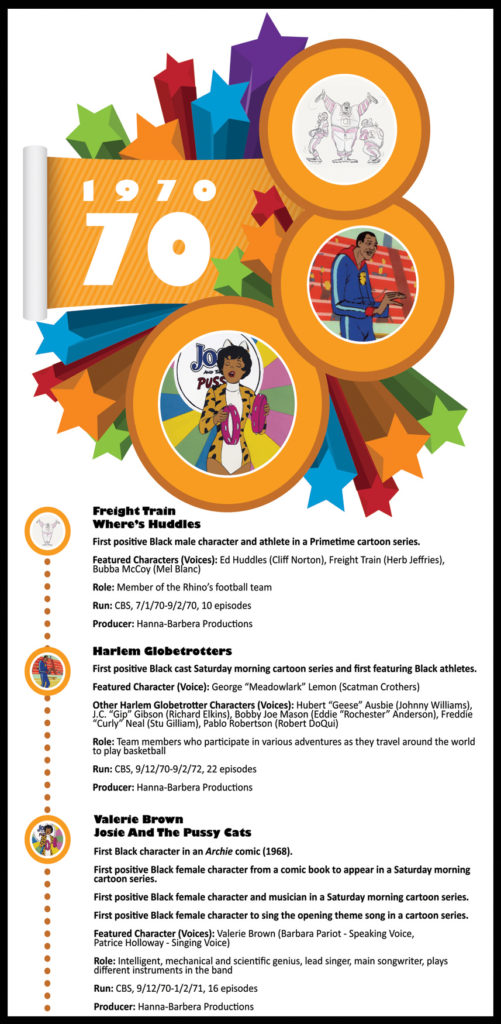
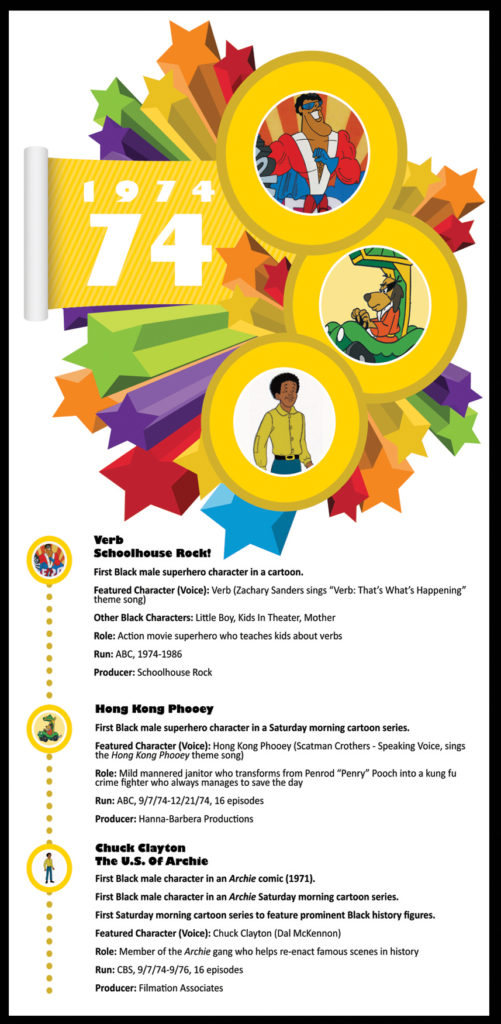

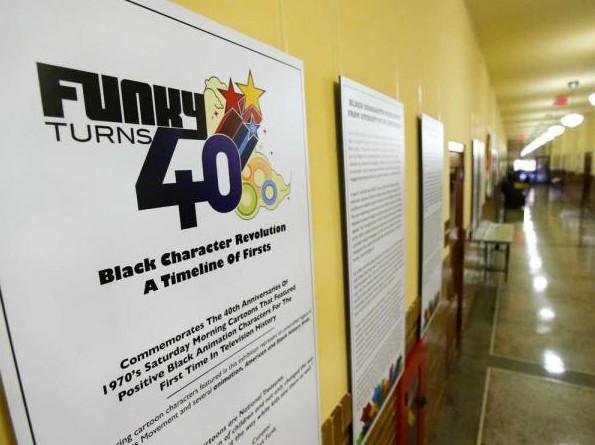
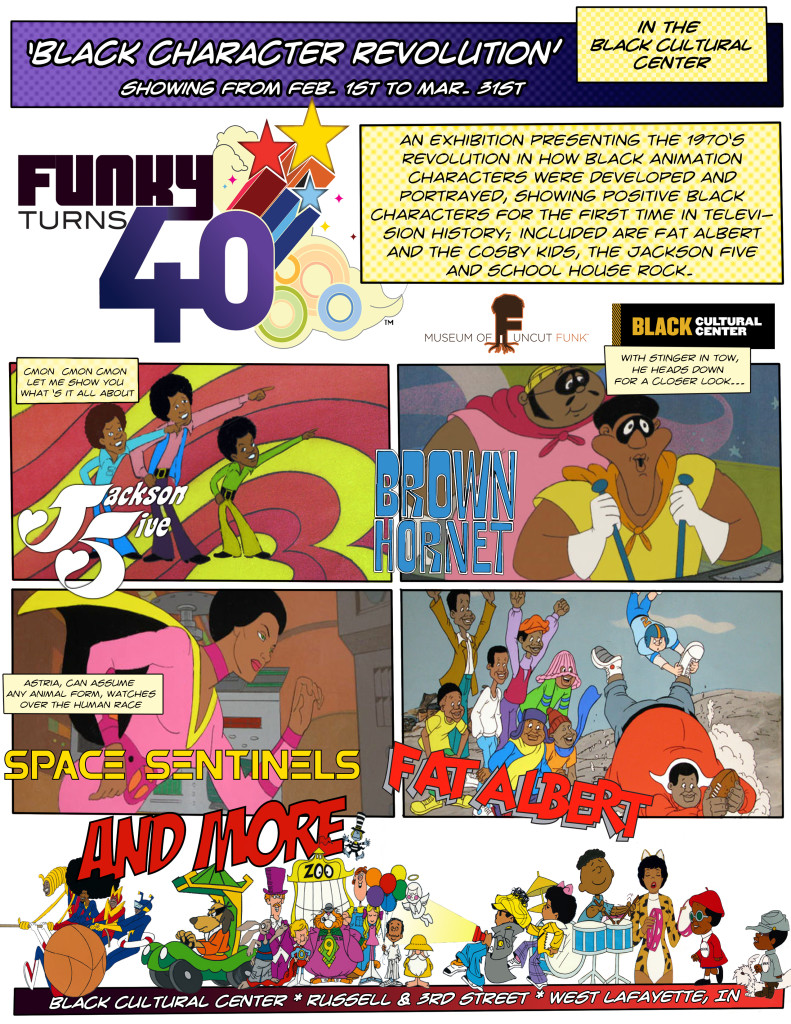
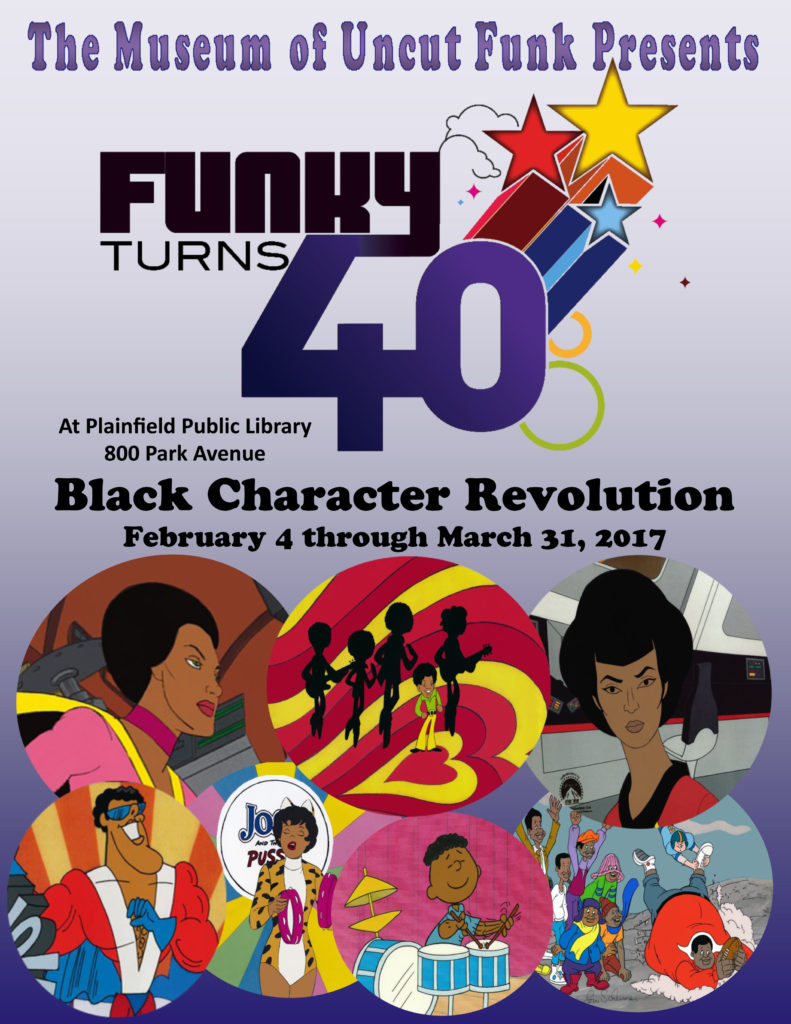
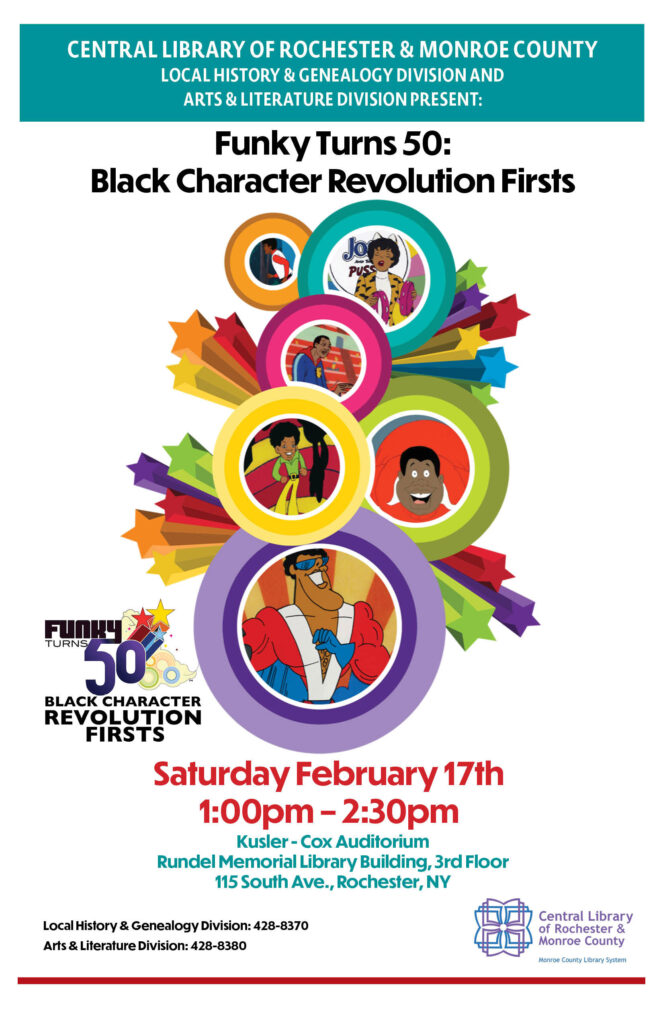
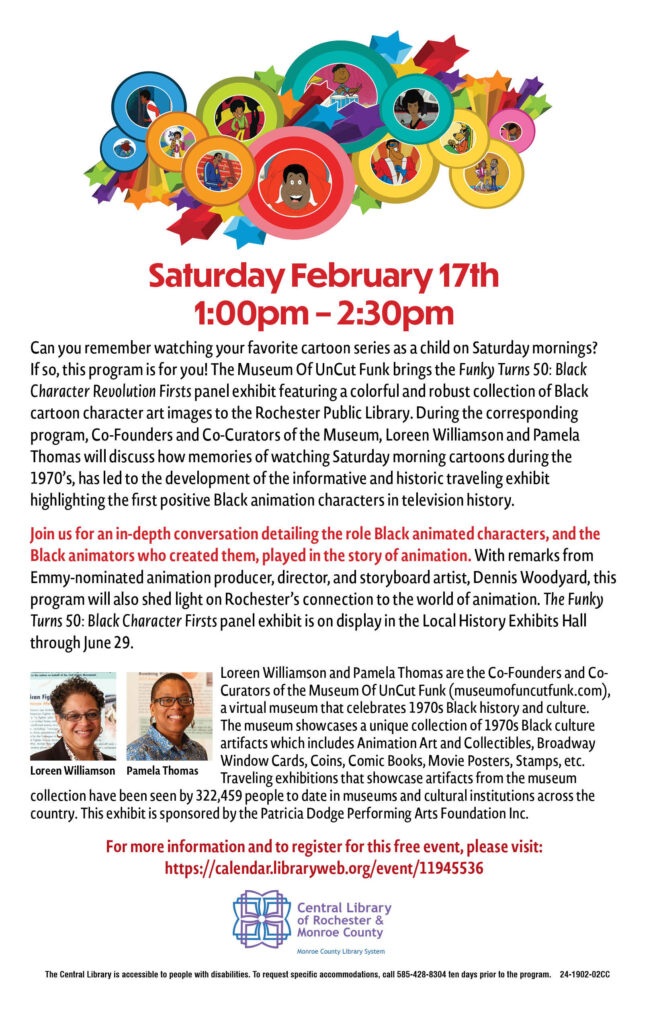

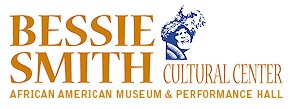



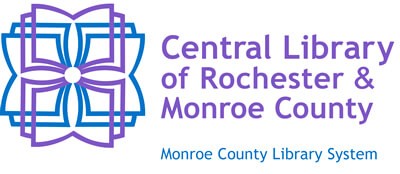
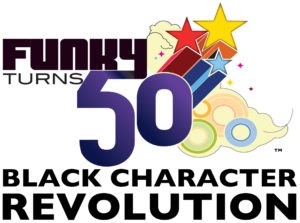
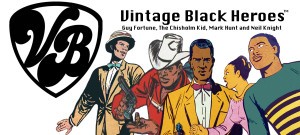
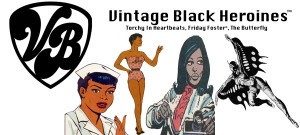

0 Comments